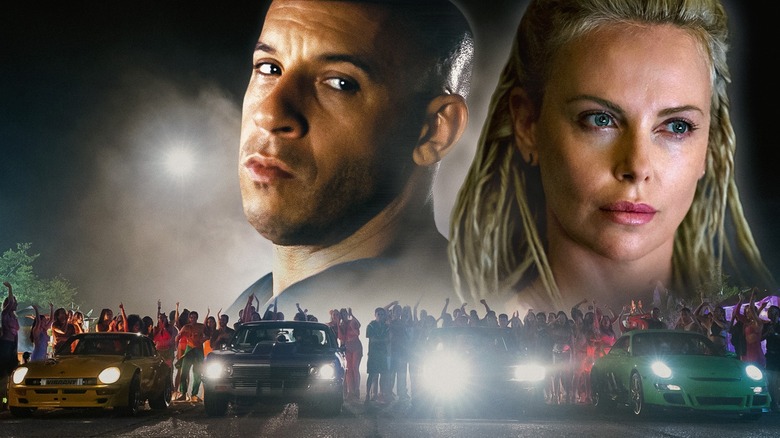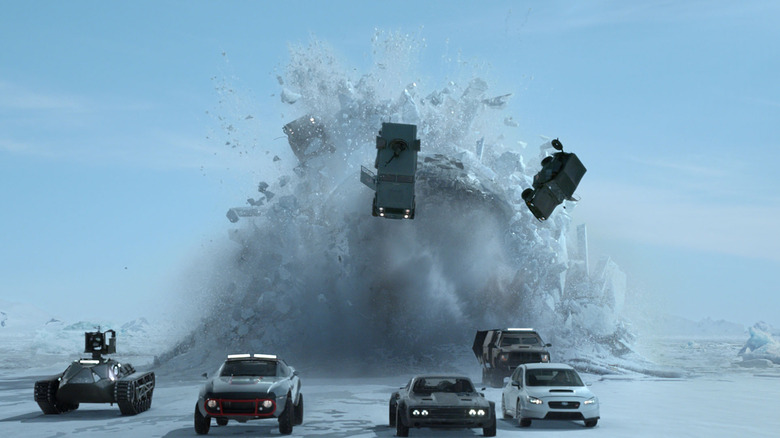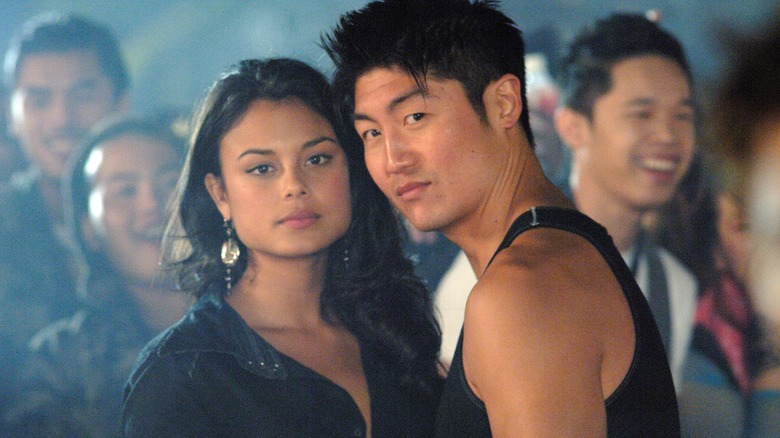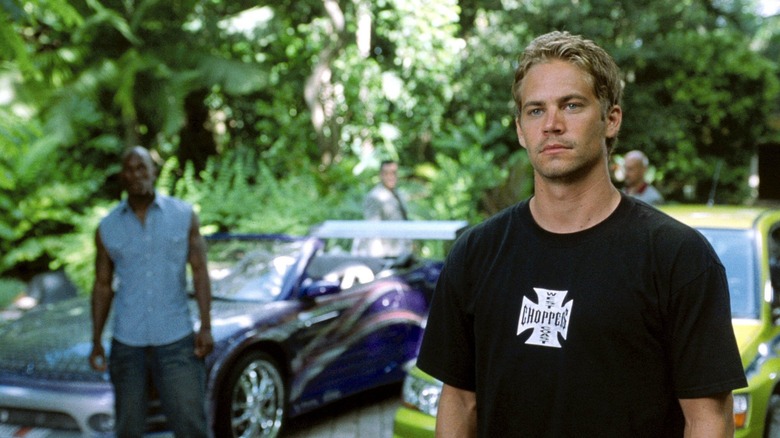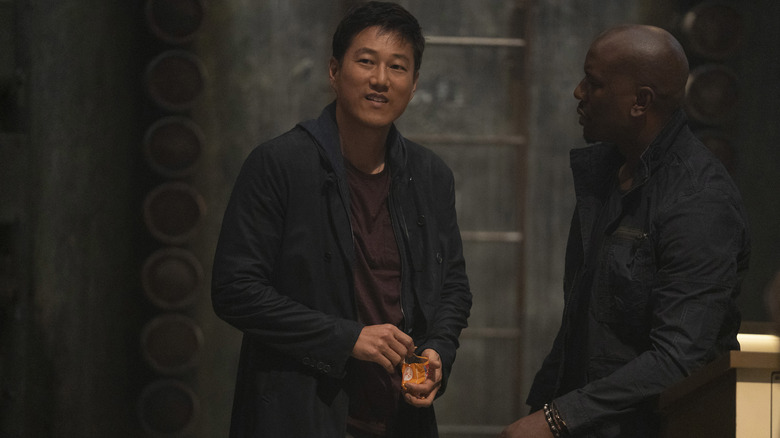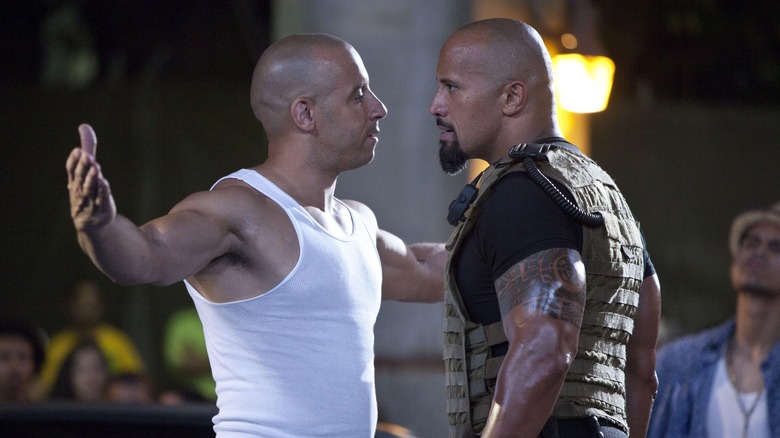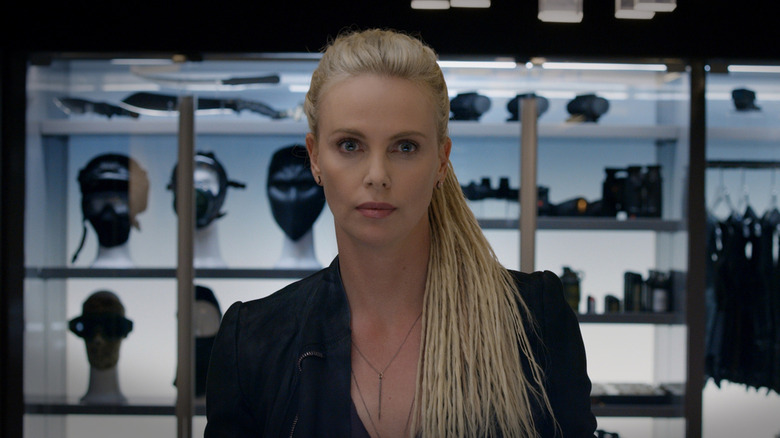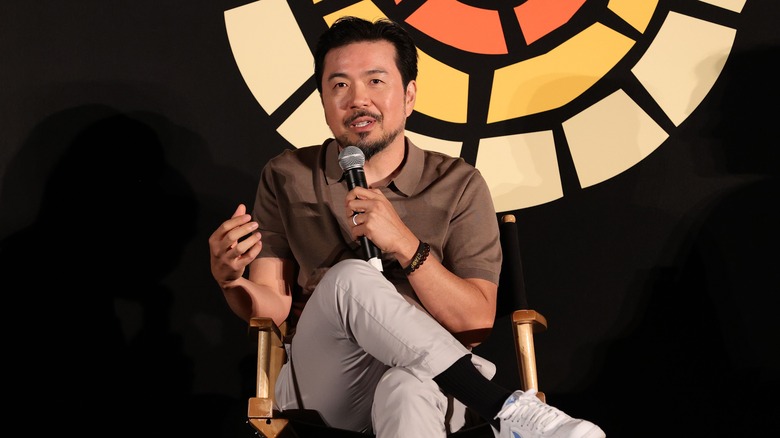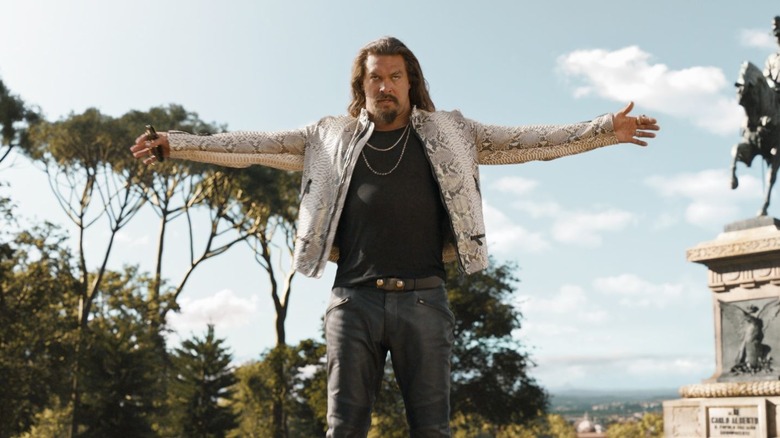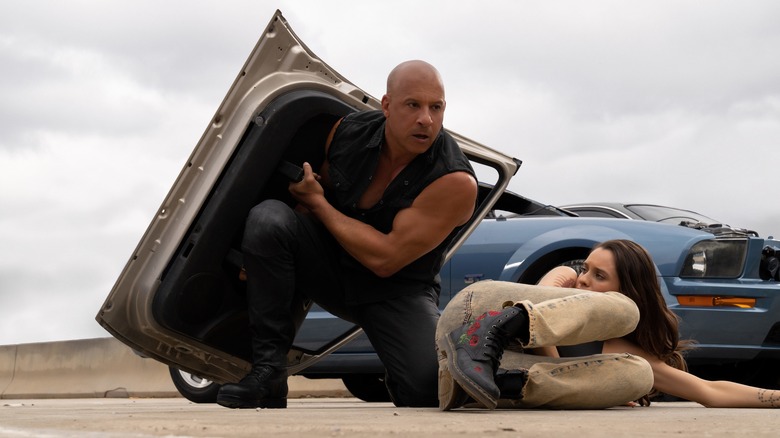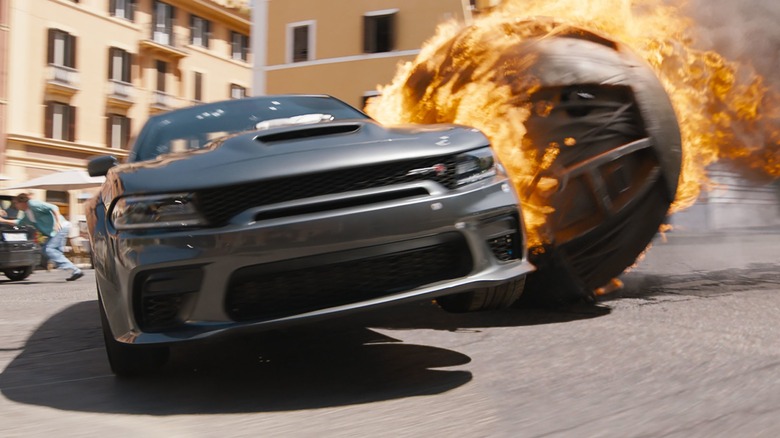Things The Fast And Furious Franchise Should Be Embarrassed About
The "Fast and Furious" movies have never been known for their realism, seriousness, or cinematic artistry. Quite the contrary, they're perhaps the most famously stupid films of the 21st century. That's why fans around the world love them, but the goofiness isn't always a good thing.
Inevitably, when you tell stories about street racers who become international super spies, you're going to hit some weird moments. And most of the time, it's worth the tradeoff. Moments like Brian (Paul Walker) and Dom (Vin Diesel) jumping a supercar between two skyscrapers or Tej (Ludacris) and Roman (Tyrese Gibson) flying a Pontiac Fiero into space are what make the series so great. Speeches about family, drag race philosophy, racing a nuclear submarine in a Lamborghini — it's a winning formula.
Then there are the less savory bits of strangeness, like the constant retcons and occasional bizarre character choices. And that's without getting into all of the behind-the-scenes drama that the "Fast" series has dealt with over the years. You can have all the box office success in the world, but it won't erase the bad bits. To that end, here are some things that the "Fast and Furious" franchise should definitely be embarrassed about.
That's not how cars work
When "The Fast and the Furious" premiered in 2001, it quickly raced its way into the hearts of gearheads everywhere. Many cite the film as the reason that a whole generation got into car culture. It brought together both Japanese imports and classic American muscle cars under one umbrella, and the glitz and glamour of the street racing scenes came to define the sport in the eyes of many.
All that said, "Fast and Furious" has never been the most accurate when it comes to the actual science behind the cars. The racing scenes of the early movies are still lots of fun, but their style has only gotten sillier in retrospect. A common joke about the franchise is that characters upshift gears way more in a single race than could possibly make sense. It's also sadly true that nitrous oxide isn't quite as dramatic in practice as it is in the movies. Yes, it makes your car go faster, but it's hardly a "Mario Kart" mushroom.
In the later movies, things only get more ridiculous. The "Fast Five" vault heist stands out as a particularly egregious example, wherein a massive block of solid steel is pulled around Rio as if it were a giant rubber ball. We won't even get into the tank race or the likelihood of a Pontiac Fiero breaking atmosphere without imploding. These are the things that make "Fast and Furious" great, but we'd be lying if we said they make sense.
The treatment of women
In more recent years, "Fast and Furious" has been one of the better blockbuster franchises for gender equity and representation. Letty (Michelle Rodriguez), Mia (Jordana Brewster), Ramsey (Nathalie Emmanuel), Giselle (Gal Gadot), and many others have joined the crew over the last two decades, balancing out the series' natural machismo with plenty of compelling female characters. But of course, it hasn't always been like that.
Early entries, especially "Tokyo Drift," are pretty rotten when it comes to how the women are written. Neela (Nathalie Kelley) is quite literally a prize for Sean Boswell (Lucas Black) to win, and she's the only woman in the whole movie who gets any meaningful lines. A similar thing happens in "2 Fast 2 Furious." Eva Mendes' Agent Monica Fuentes is supposed to be on equal footing with Brian and Roman, but she hardly gets any material. Suki (Devon Aoki) gets a bit more to do, but of course, she's also one of the only "Fast and Furious" characters never to return after her debut. Then there's the series' trend of killing off female characters for dramatic effect, which happens to Letty, Giselle, and Elena (Elsa Pataky). Yes, two of those characters get resurrected later on, but it's still a tired trope. And that's without even mentioning the obligatory scantily clad street racing montages in every movie.
You might find it silly to criticize a franchise about cars and explosions for not being gender-inclusive enough. But as "Fast and Furious" has gotten better at handling its female characters, the times when it dropped the ball feel all the more embarrassing.
When Brian said 'cuz'
If you're looking for the silliest entry in the franchise, "2 Fast 2 Furious" may just be it. It's a contender on the merits of the name alone, but the content is also some of the goofiest in the whole series. Director John Singleton brought his expertise and craftsmanship to bear on the look and feel of the film, which is where it shines. The screenplay from Michael Brandt and Derek Haas, however, is less impressive.
We could do a whole breakdown on how Roman is written in the film — a characterization that's only saved from abject stereotype by Tyrese Gibson's endlessly entertaining performance. But the bigger culprit, arguably, is Brian, whose dialogue throughout the film skews uncomfortably close to that white guy who insists on singing every lyric in a Jay-Z song.
The first movie and later entries all give Paul Walker better material — writing that works for who Brian is. But in "2 Fast," he mostly just feels like a poser. His insistence on using the word "cuz" or "cuh" when talking to Roman is, to put it lightly, bad. It might make you chuckle, but it's also quite embarrassing. Thankfully, this is the kind of writing that "Fast and Furious" has (mostly) gotten away from in the ensuing years.
The way Han was treated
There is perhaps no more notorious piece of the "Fast and Furious" story than the way Han (Sung Kang) was treated for years after his "death." Though he's killed off in "Tokyo Drift," Han became so popular that director Justin Lin and the producers decided to move that film further forward in the timeline. "Fast and Furious," "Fast Five," and "Fast and Furious 6" all take place before "Tokyo Drift" in the timeline, despite being released years after.
That's all well and good, and there's nothing intrinsically wrong with killing off a character. The problem came in how Han was treated after "Furious 7." Deckard Shaw (Jason Statham), the character responsible for brutally murdering Han, was made an ally of the crew in "The Fate of the Furious." He and Dom seemingly settled their beef, ending the vendetta begun by Han's death. This does kind of make sense within the framework of the films, as Shaw helps Dom save his son from Cipher (Charlize Theron), thus earning a sort of ceasefire. But when it's both your only Asian character and a fan favorite, the people are going to be upset.
Audiences responded with the #JusticeForHan hashtag campaign, demanding that the character be given a more fair deal. This ultimately led to Han being resurrected in "F9: The Fast Saga," thus ending the outrage. But even still, the way his death was handled remains an embarrassing piece of "Fast and Furious" history.
Losing The Rock from the main franchise
"Fast and Furious" was already a big success by the time Dwayne Johnson joined in the fun, but his star power certainly helped magnify the profile of the franchise. When "Fast Five" premiered, Johnson was on the brink of superstardom, but he hadn't yet crossed that gap. His performance as Luke Hobbs became mutually beneficial — he lifted the series, and the series lifted him.
For the next two "Fast and Furious" movies, both Johnson's star and the box office returns continued to rise. It seemed like the sky was the limit. After Paul Walker's tragic death, Dom and Hobbs' relationship became even more important, embodying the theme of chosen brotherhood that was once carried by Dom and Brian. And then, of course, everything fell apart.
At this point, Johnson's feud with Vin Diesel is well documented. The simple version is that the two massive men apparently developed equally massive egos — big enough that the set of "Fast and Furious" was no longer big enough for the two of them. Since Diesel was more established in the series (and a producer), Johnson ended up departing, first being shoehorned into a dismally received spinoff and then leaving entirely. For years, the franchise felt the weight of his absence in a big way, and the movies undeniably suffered. This major misstep has seemingly been fixed by Johnson's return at the end of "Fast X," but losing him for multiple movies is still something the franchise and Diesel should both be embarrassed about.
Cipher's dreadlocks
For "The Fate of the Furious," the writers and producers at Universal decided to introduce a new kind of villain to the "Fast" franchise. Charlize Theron was cast, bringing a golden combination of both star power and spectacular acting talent. Thus, the birth of Cipher — a brilliant and obnoxious hacker and cyberterrorist who went on to become the franchise's longest-running primary antagonist.
There was just one problem: For some absolutely inexplicable reason, hair and makeup decided to give Cipher dreadlocks. The white villain whose grand plan is basically Karen-ing the protagonists into submission has dreadlocks, and it's never addressed.
There's an argument to be made that this is a smart bit of character work — a sign to the audience that Cipher is a bad person on multiple levels. She's an internationally wanted terrorist with ambitions of world domination, but she also thinks that cultural appropriation is neat. Fits, right? It does, but nothing in the film suggests that this was the reason for the dreadlocks. As it stands, it's just plain old bad taste. By the next movie, Cipher got a new, far less controversial hairdo. "Fast and Furious," do better.
Pushing out Justin Lin
Dwayne Johnson isn't the only person to have been pushed out of "Fast and Furious" due to clashes with Vin Diesel. Director Justin Lin, who helmed the franchise from "Tokyo Drift" all the way to international blockbuster status through "Fast and Furious 6," left for two movies but came back for "F9: The Fast Saga." He was also signed on to direct "Fast X," but he left shortly into production. According to reports, creative disagreements with Diesel were the main cause of his departure.
The results of Lin's absence speak for themselves. "The Fate of the Furious" and "Fast X" are two of the worst-reviewed installments in the franchise, and though Lin helmed another entry on that list with "Tokyo Drift," his wins far outweigh his losses. The ensemble "Avengers"-style dynamic of the cast, the ever-more-ridiculous action set pieces, the international box office success that elevated the brand to the peak of Hollywood — all of those developments took place under Lin's guidance. Losing him during what's supposedly the finale of the franchise is a huge blow.
Even though Universal reps told The Hollywood Reporter that Lin's issues were strictly with the studio, other sources claimed that Diesel played a major role. On-set rewrites and a lack of creative control allegedly led to a powder keg, and Lin quit to prioritize his mental health. The ratings of "Fast X" in his absence tell the rest of the story pretty clearly.
Zero queer representation
It's strange to say, but "Fast and Furious" has become one of the better blockbuster franchises for diversity and representation. Later movies have maintained a (mostly) solid gender balance, and the cast is far more racially diverse than you typically get with massive Hollywood action flicks. Perhaps that's part of why the franchise performs so well internationally. Regardless, "Fast and Furious" falls short in one particular category — its queer representation is basically zero.
To be fair, plenty of similar series could get the same criticism. But because "Fast and Furious" does so well in other areas of equity and inclusion, the extreme straightness of the world stands out. Some fans may not want to hear about the blatant homoeroticism in Tej and Roman's friendship, but sorry, we don't make the rules. The two of them are meant to form a throuple with Ramsey. You know it to be true.
The closest thing we've gotten to an actual queer character in "Fast and Furious" is Jason Momoa's "Fast X" villain Dante Reyes. And while his colorful clothes and flamboyant personality make him more fun to watch than most "Fast" baddies, a queer-coded antagonist isn't the same as actual representation. Depending on your point of view, Dante might even read like a harmful stereotype, continuing an age-old Hollywood trend of queer-coding villains on the brink of insanity. It's not a great look.
Giving up on character development
"Fast and Furious" has never really been about the story or the quality of the writing, but it has had some genuinely great narrative moments. Dom and Brian's journey from enemies on opposite sides of the law to literal brothers is simple but effective, as is Dom's relationship with Letty. Paul Walker's death is handled shockingly well in "Furious 7," and the powerful way that Brian is written out of the story remains a highlight of the series.
Simple but effective — for years, that was the name of the game in "Fast and Furious." But somewhere along the way, Vin Diesel and the other producers and writers seemed to give up on exploring new character arcs. This is most evident in "Fast X," where Dom becomes such a force of nature that he's more of an action figure than an actual person. But you can trace the trend back even earlier to "The Fate of the Furious."
It's an understandable dilemma. When the same story runs in theaters for more than two decades, you're inevitably going to run out of prime material. That's an explanation, but it's not an excuse. Watching fan-favorite stock characters is fun for a while, but the last few "F&F" movies have unquestionably had diminishing returns. They refuse to do anything truly new or groundbreaking with the characters, and the emotional hooks have slowly vanished as a result.
Too many retcons
At this point, the tendency of "Fast and Furious" movies to majorly retcon previous storylines is a meme in itself. It started off innocuously enough with Letty being brought back from the dead in a post-credits scene at the end of "Fast 5." Did that make a lot of sense, given that she's shown dying by car explosion in the fourth movie? No. No, it did not. But fans universally agreed that they'd rather have Michelle Rodriguez back than preserve some silly continuity. Letty returned, and the franchise is better for it.
But then it just ... kept happening. Han's accidental death in "Tokyo Drift" was retconned in "Furious 7" to be the work of Deckard Shaw, and then retconned a second time in "F9: The Fast Saga" to have been a ruse so that Han could go into hiding. And of course, once Han came back, it made sense to bring his love interest back too, so Giselle inexplicably returns from the dead at the end of "Fast X."
These resurrections aren't necessarily bad. It's always fun to see fan-favorite characters return, after all, and the series has become so absurd that reviving the dead almost feels logical. But at some point, "Fast and Furious" just crossed a line. It's not just character deaths, but the motivations behind major scenes, like Dante Reyes being retconned into the background of "Fast Five." If everything changes, then nothing has any stakes. Plus, it's embarrassing to pretend like obvious retcons were being planned the whole time.
Too much CGI in Fast X
Ever since they graduated from street racing to blockbuster action (and even before), the "Fast and Furious" movies have heavily employed CGI in their set pieces. It's kind of a requirement when it comes to doing the impossible things the films attempt, but most of the movies still use a lot of real cars and practical effects to keep things balanced. However, "Fast X" takes things a bit too far, leaning on CGI as a crutch and eschewing many of the practical stunts that previously made the movies so exciting.
It didn't do the film any favors that it was released just a couple of months before "Mission: Impossible — Dead Reckoning Part One. The spy series is known for embracing practical effects and stunts, and both movies feature chase sequences through the streets of Rome. Where the "Mission: Impossible" sequence is full of real driving from Tom Cruise and mostly practical effects, Dom's chase after a massive bomb ball is some of the worst computer-modified action mush that "Fast and Furious" has ever displayed. The "Mission: Impossible — Dead Reckoning" scene puts "Fast X" to shame, driving home just how far the "Fast" franchise as a whole has fallen from its peak.
